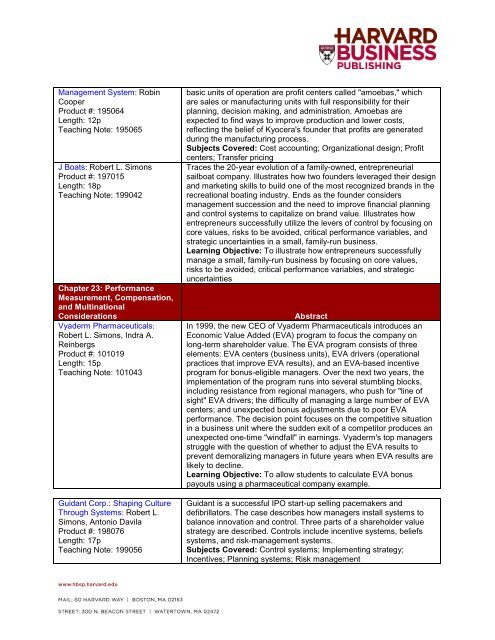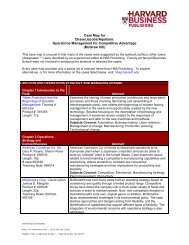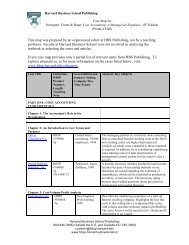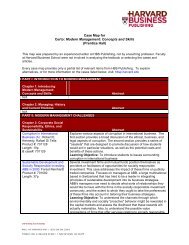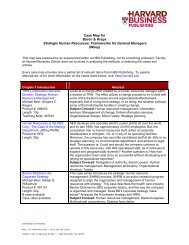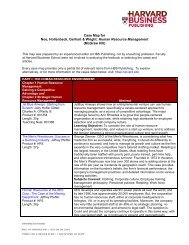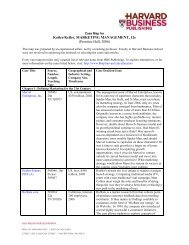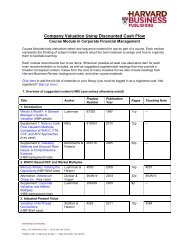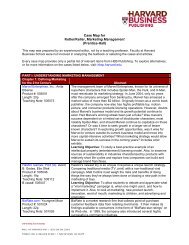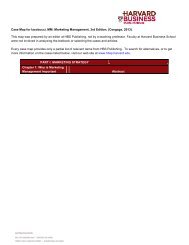Case Map for Horngren, Foster & Datar: Cost Accounting - Harvard ...
Case Map for Horngren, Foster & Datar: Cost Accounting - Harvard ...
Case Map for Horngren, Foster & Datar: Cost Accounting - Harvard ...
Create successful ePaper yourself
Turn your PDF publications into a flip-book with our unique Google optimized e-Paper software.
Management System: Robin<br />
Cooper<br />
Product #: 195064<br />
Length: 12p<br />
Teaching Note: 195065<br />
J Boats: Robert L. Simons<br />
Product #: 197015<br />
Length: 18p<br />
Teaching Note: 199042<br />
Chapter 23: Per<strong>for</strong>mance<br />
Measurement, Compensation,<br />
and Multinational<br />
Considerations<br />
Vyaderm Pharmaceuticals:<br />
Robert L. Simons, Indra A.<br />
Reinbergs<br />
Product #: 101019<br />
Length: 15p<br />
Teaching Note: 101043<br />
Guidant Corp.: Shaping Culture<br />
Through Systems: Robert L.<br />
Simons, Antonio Davila<br />
Product #: 198076<br />
Length: 17p<br />
Teaching Note: 199056<br />
basic units of operation are profit centers called "amoebas," which<br />
are sales or manufacturing units with full responsibility <strong>for</strong> their<br />
planning, decision making, and administration. Amoebas are<br />
expected to find ways to improve production and lower costs,<br />
reflecting the belief of Kyocera's founder that profits are generated<br />
during the manufacturing process.<br />
Subjects Covered: <strong>Cost</strong> accounting; Organizational design; Profit<br />
centers; Transfer pricing<br />
Traces the 20-year evolution of a family-owned, entrepreneurial<br />
sailboat company. Illustrates how two founders leveraged their design<br />
and marketing skills to build one of the most recognized brands in the<br />
recreational boating industry. Ends as the founder considers<br />
management succession and the need to improve financial planning<br />
and control systems to capitalize on brand value. Illustrates how<br />
entrepreneurs successfully utilize the levers of control by focusing on<br />
core values, risks to be avoided, critical per<strong>for</strong>mance variables, and<br />
strategic uncertainties in a small, family-run business.<br />
Learning Objective: To illustrate how entrepreneurs successfully<br />
manage a small, family-run business by focusing on core values,<br />
risks to be avoided, critical per<strong>for</strong>mance variables, and strategic<br />
uncertainties<br />
Abstract<br />
In 1999, the new CEO of Vyaderm Pharmaceuticals introduces an<br />
Economic Value Added (EVA) program to focus the company on<br />
long-term shareholder value. The EVA program consists of three<br />
elements: EVA centers (business units), EVA drivers (operational<br />
practices that improve EVA results), and an EVA-based incentive<br />
program <strong>for</strong> bonus-eligible managers. Over the next two years, the<br />
implementation of the program runs into several stumbling blocks,<br />
including resistance from regional managers, who push <strong>for</strong> "line of<br />
sight" EVA drivers; the difficulty of managing a large number of EVA<br />
centers; and unexpected bonus adjustments due to poor EVA<br />
per<strong>for</strong>mance. The decision point focuses on the competitive situation<br />
in a business unit where the sudden exit of a competitor produces an<br />
unexpected one-time "windfall" in earnings. Vyaderm's top managers<br />
struggle with the question of whether to adjust the EVA results to<br />
prevent demoralizing managers in future years when EVA results are<br />
likely to decline.<br />
Learning Objective: To allow students to calculate EVA bonus<br />
payouts using a pharmaceutical company example.<br />
Guidant is a successful IPO start-up selling pacemakers and<br />
defibrillators. The case describes how managers install systems to<br />
balance innovation and control. Three parts of a shareholder value<br />
strategy are described. Controls include incentive systems, beliefs<br />
systems, and risk-management systems.<br />
Subjects Covered: Control systems; Implementing strategy;<br />
Incentives; Planning systems; Risk management


